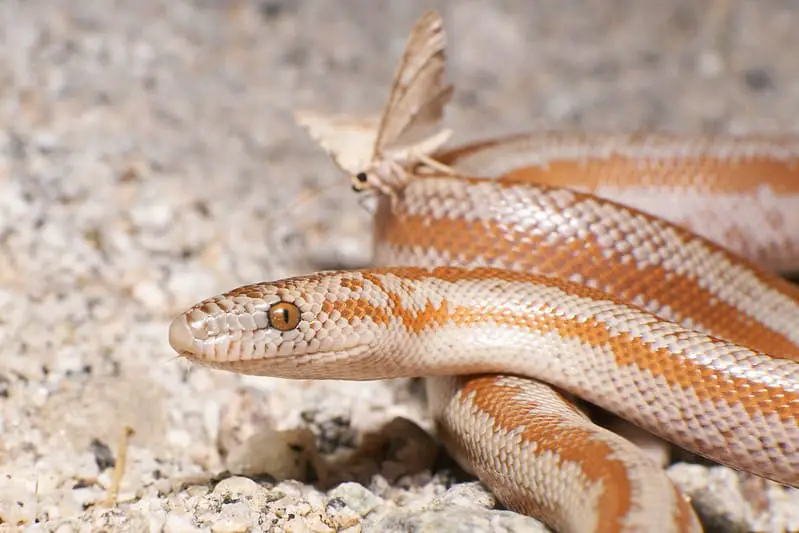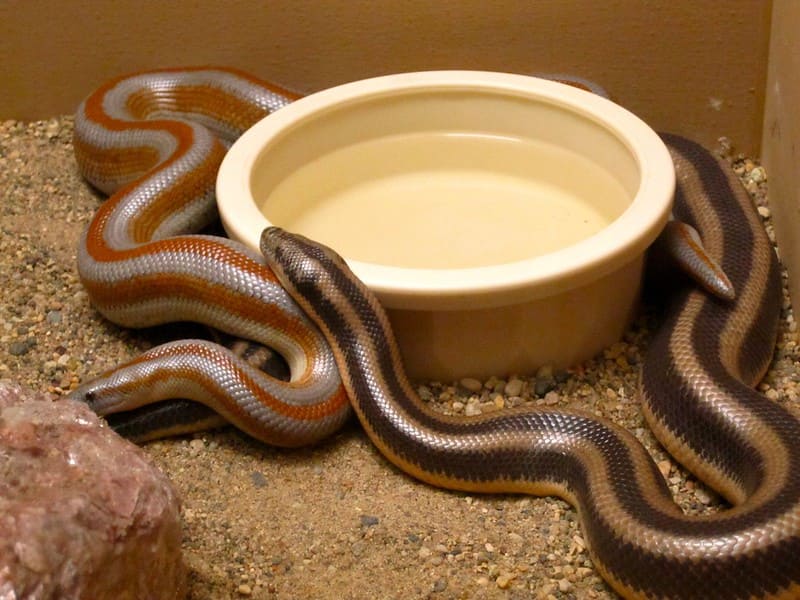Choosing a pet is a significant decision, and one of the most important factors to consider is whether the animal you’re interested in is a suitable pet for you. In recent years, many exotic pets have gained popularity, including reptiles like Rosy Boas. Rosy Boas are a type of snake native to North America and are known for their beautiful coloration and relatively small size. This article will explore the suitability of Rosy Boas as pets, considering various aspects such as care requirements, temperament, and potential challenges.

What are Rosy Boas?
Species and Distribution
Rosy Boas, scientifically known as Lichanura spp., are a group of non-venomous, medium-sized constrictor snakes belonging to the Boidae family. There are three recognized species within this genus: the Coastal Rosy Boa (Lichanura trivirgata), the Desert Rosy Boa (Lichanura trivirgata gracia), and the Baja California Rosy Boa (Lichanura trivirgata roseofusca). These snakes are primarily found in the southwestern United States and northwestern Mexico, inhabiting a variety of environments, from deserts to coastal areas.
Physical Characteristics
Rosy Boas are known for their striking appearance. They typically have a slender, elongated body, with a length ranging from 2 to 4 feet. Their coloration can vary significantly depending on the specific locality, but they are generally characterized by bands of alternating light and dark colors, which can give them a rosy or pinkish appearance. These bands can be shades of pink, brown, orange, and cream, with some variations such as striped patterns. Their scales are smooth, and their head is relatively small and wedge-shaped.
Lifespan
In captivity, Rosy Boas have the potential to live for an impressive 20 to 30 years, making them a long-term commitment for pet owners.
Are Rosy Boas Good Pets?
Deciding whether Rosy Boas make good pets is a complex matter that requires considering various aspects of their care, behavior, and the responsibilities involved. Let’s delve into these factors to better understand the suitability of Rosy Boas as pets.
1. Temperament
One of the first factors to consider when determining the suitability of a pet is its temperament. Rosy Boas are generally known for their calm and docile nature. They are not aggressive by nature and are unlikely to bite unless they feel threatened or cornered. However, it’s essential to keep in mind that individual temperament can vary, so selecting a captive-bred Rosy Boa from a reputable breeder is recommended.
The calm demeanor of Rosy Boas makes them a good choice for novice reptile keepers or individuals who are not comfortable with the idea of handling a highly defensive or aggressive reptile. Their mild temperament also makes them a suitable option for families with responsible children interested in keeping a pet snake.
2. Size and Handling
The relatively small size of Rosy Boas is an advantage when it comes to handling them. They are more manageable in size compared to larger snake species, which can be beneficial for those who want a pet snake but have limited space or are intimidated by handling larger snakes. The ease of handling Rosy Boas can contribute to a positive pet-keeping experience for both beginners and experienced reptile enthusiasts.
It’s important to remember that Rosy Boas, like all snakes, require proper handling techniques to ensure their safety and the handler’s safety. Gentle and careful handling is essential to prevent unnecessary stress and potential harm to the snake.
3. Housing and Enclosure
Rosy Boas have specific housing requirements that need to be met to ensure their well-being. When kept as pets, they should be provided with a secure and appropriately sized enclosure. The enclosure should mimic their natural habitat and include features such as hiding spots, a water dish, and a suitable substrate.
The size of the enclosure depends on the size of the snake, with hatchlings requiring smaller enclosures and adults needing more space. A general rule of thumb is to provide at least one square foot of space per foot of snake length. This means that a 3-foot-long Rosy Boa would need a 3-square-foot enclosure, but more space is always better.
4. Diet and Feeding
Feeding Rosy Boas is relatively straightforward. They are carnivorous and primarily eat small mammals such as mice and rats. The frequency of feeding depends on the age and size of the snake. Hatchlings may need to be fed every 5-7 days, while adults can be fed every 10-14 days. It’s crucial to offer appropriately sized prey items to prevent regurgitation and ensure the snake can swallow its meal without difficulty.
One challenge in feeding Rosy Boas, as well as other snakes, is the need for frozen-thawed prey items. Live prey can pose a risk to the snake, as the prey animal might injure the snake in self-defense. Feeding frozen-thawed prey items is a safer and more ethical option.
5. Temperature and Humidity
Maintaining the correct temperature and humidity levels in the enclosure is crucial for the health of your Rosy Boa. As a desert-dwelling species, they require a basking area with temperatures ranging from 85-90°F (29-32°C) and a cooler area in the mid-70s°F (24-26°C). Nighttime temperatures can drop by a few degrees but should remain relatively stable.
Maintaining the proper humidity level is equally important. Desert Rosy Boas need lower humidity levels compared to their coastal counterparts. It’s essential to provide a humidity gradient by misting one area of the enclosure, while the rest remains relatively dry.
6. Environmental Enrichment
Enrichment is a critical aspect of reptile care. While Rosy Boas are generally less active compared to some other snake species, providing environmental enrichment can help keep them mentally and physically stimulated. This can be achieved by incorporating climbing structures, different substrate types, and varied hiding spots in their enclosure. Additionally, offering items to explore and investigate can promote the snake’s overall well-being.
7. Health and Veterinary Care
Regular health check-ups and proper care are essential for the well-being of your Rosy Boa. It’s recommended to find a veterinarian who specializes in reptiles to ensure your snake receives appropriate care when needed. Common health concerns in Rosy Boas include respiratory infections, parasites, and skin issues. Regular cleaning and maintenance of the enclosure can help prevent these issues.
8. Legal Considerations
Before acquiring a Rosy Boa as a pet, it’s essential to check your local, state, and national laws and regulations regarding the ownership of this species. Some areas may have restrictions or require permits for keeping Rosy Boas as pets. Ensuring you are compliant with these regulations is crucial to avoid legal issues.

Potential Challenges
While Rosy Boas can make great pets for the right individuals, there are some challenges and considerations that potential owners should be aware of:
1. Long Lifespan
The long lifespan of Rosy Boas is both an advantage and a challenge. While it means that you can enjoy their companionship for decades, it also necessitates a significant long-term commitment. You must be prepared to provide care and attention to your pet snake throughout its entire life.
2. Specialized Habitat Requirements
Providing the proper habitat for your Rosy Boa can be more complex than it may seem at first. Ensuring that temperature, humidity, and substrate are appropriate and consistent requires careful monitoring and maintenance. Additionally, setting up a suitable enclosure can be expensive and time-consuming.
3. Feeding and Prey Items
Some potential Rosy Boa owners may be uncomfortable with the idea of feeding snakes whole rodents. Feeding frozen-thawed prey items is an ethical and safe option, but it can still be challenging for some individuals. Additionally, you need a reliable source of appropriately sized prey items, which may not be readily available in all areas.
4. Space and Enclosure Size
While Rosy Boas are small in comparison to some other snake species, they still require a suitable amount of space. Providing an adequately sized enclosure can be challenging if you have limited living space or are unsure of how to set up the enclosure correctly.
5. Potential Health Issues
Like all pets, Rosy Boas can develop health issues, and veterinary care for reptiles can be costly and hard to find in some areas. You must be prepared for the possibility of health concerns and the financial responsibility that comes with addressing them.
6. Handling and Temperament Variability
While Rosy Boas are generally docile, individual temperament can vary. Some may be more nervous or prone to stress, which can affect their handling. It’s essential to be patient and gentle when working with your Rosy Boa to build trust and minimize stress.
Conclusion
Rosy Boas can be excellent pets for the right individuals who are willing to invest the time, effort, and resources required for their care. They are known for their calm temperament, manageable size, and stunning appearance. However, potential owners must be aware of the challenges associated with their care, including long lifespans, specific habitat requirements, and potential health issues. Before acquiring a Rosy Boa as a pet, it’s crucial to research and prepare for the responsibilities that come with keeping these beautiful snakes. If you are willing to meet these responsibilities, a Rosy Boa can be a rewarding and fascinating addition to your household, providing years of enjoyment and companionship.
